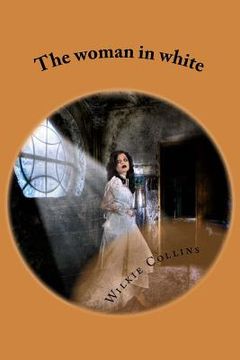Reseña del libro "The woman in white (en Inglés)"
Résume The Woman in White is Wilkie Collins' fifth published novel, written in 1859. It is considered to be among the first mystery novels and is widely regarded as one of the first (and finest) in the genre of "sensation novels". The story is sometimes considered an early example of detective fiction with the hero, Walter Hartright, employing many of the sleuthing techniques of later private detectives. The use of multiple narrators draws on Collins's legal training, and as he points out in his Preamble: "the story here presented will be told by more than one pen, as the story of an offence against the laws is told in Court by more than one witness". In 2003, Robert McCrum writing for The Observer listed The Woman in White number 23 in "the top 100 greatest novels of all time", and the novel was listed at number 77 on the BBC's survey The Big Read. Walter Hartright, a young art teacher, meets a mysterious and distressed woman dressed in white. He helps her on her way, but later learns that she has escaped from an asylum. Next day, he travels to Limmeridge House in Cumberland, having been hired as a drawing master on the recommendation of his friend, Pesca, an Italian language master. The Limmeridge household comprises the invalid Frederick Fairlie, and Walter's students: Laura Fairlie, Mr Fairlie's niece, and Marian Halcombe, her devoted half-sister. Walter realises that Laura bears an astonishing resemblance to the woman in white, who is known to the household and whose name is Anne Catherick. The mentally disabled Anne had lived near Limmeridge as a child and was devoted to Laura's mother, who first dressed her in white. Walter and Laura fall in love. Laura, however, has promised her father that she will marry Sir Percival Glyde. Marian - knowing that Laura loves Walter in return - advises Walter to forget his love, and leave Limmeridge. Anne, after sending a letter to Laura warning her against Glyde, meets Walter who becomes convinced (wrongly) that Glyde was Anne's lover, or was responsible for putting Anne into the asylum. Despite the misgivings of the family lawyer over the financial terms of the marriage settlement, Laura and Glyde marry in December 1849 and travel to Italy for six months. Walter also leaves England, joining an expedition to Honduras. After their honeymoon, Sir Percival and Lady Glyde return to his house, Blackwater Park in Hampshire; they are accompanied by Glyde's friend, Count Fosco (who is married to Laura's aunt). Marian is also living at Blackwater and learns that Glyde is in financial difficulties. Glyde unsuccessfully attempts to bully Laura into signing a document which would allow him to use her marriage settlement of 20,000. Glyde reveals to Fosco the resemblance between Laura and Anne, and Fosco and Glyde plot to switch the identities of Laura and the terminally-ill Anne, so that Anne's death can be passed off as Laura's and Glyde can inherit. Marian crawls out onto a roof and eavesdrops on Glyde and Fosco, and it begins to rain. Marian becomes soaked, and later falls into a fever which turns into typhus.
(Londres 1824-1889) Dramaturgo, novelista y prolífico autor de relatos. A los 17 años comienza a trabajar en una empresa de comercio de té mientras escribe Ioláni, o Tahití tal como era (Gótica nº 32), obra que no vio la luz hasta más de un siglo después de su muerte. Estudió Derecho y, aunque nunca llegó a ejercer, sí utilizó los conocimientos jurídicos en muchas de sus obras, y la crítica le considera uno de los padres del género policiaco. En 1851, conoce a Charles Dickens, al que le unirá una profunda amistad y publicará en su semanario All the Year Around sus principales obras. Tras la muerte de Dickens en 1870, su popularidad decae. Padeció de gota reumática la que le acabó provocando una adicción al opio. El epitafio de su tumba le destaca como el autor de la novela La dama de blanco.
Ver más
Ver menos

